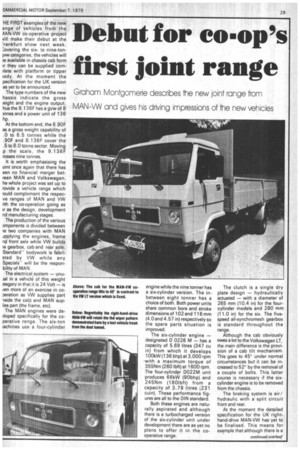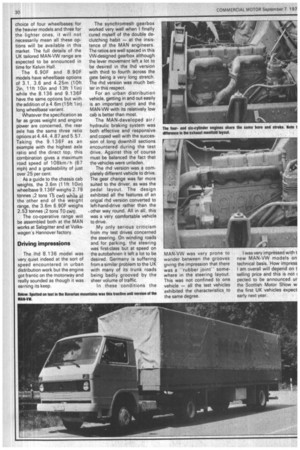Debut for co-op's first joint range
Page 31

Page 32

If you've noticed an error in this article please click here to report it so we can fix it.
Graham IVontgomerie describes the new joint range from MAN-VW and gives his driving impressions of the new vehicles
HE FIRST examples of the new ange of vehicles from the AN-VVV co-operative project will make their debut at the :rankfurt show next week. :overing the sixto nine-tonjvw categories, the vehicles will )e available in chassis cab form )r they can be supplied corn)lete with platform or tipper )ody. At the moment the pecification for the UK version as yet to be announced.
The type numbers of the new hassis indicate the gross /eight and the engine output. hus the 8.136F has a gvw of 8 )nnes and a power unit of 136 hp.
At the bottom end, the 6.90F as a gross weight capability of .0 to 6.5 tonnes while the .90F and 8.136F cover the .5 to 8.0 tonne sector. Moving p the scale, the 9.136F rosses nine tonnes.
It is worth emphasising the oint once again that there has een no financial merger betfeen MAN and Volkswagen. he whole project was set up to rovide a vehicle range which fould complement the respecve ranges of MAN and VW fith the co-operation going as ir as the design, development nd manufacturing stages.
The production of the various Dmponents is divided between le two companies with MAN applying the engines, frame rid front axle while VW builds Ie gearbox, cab and rear axle. Standardbodywork is fabriated by VW while any Specialswill be the responbility of MAN.
The electrical system — unuaal in a vehicle of this weight 3tegory in that it is 24 Volt — is ren more of an exercise in coperation as VW supplies part iside the cab) and MAN suplies part (the frame, etc).
The MAN engines were de.iloped specifically for the coperative range. The six-ton iachines use a four-cylinder engine while the nine tonner has a six-cylinder version. The inbetween eight tanner has a choice of both. Both power units share common bore and stroke dimensions of 102 and 116 mm (4.0 and 4.57 in) respectively so the spare parts situation is improved.
The six-cylinder engine — designated D 0226 M — has a capacity of 5.69 litres (347 cu in) from which it develops 100kW (136 bhp) at 3,000 rpm with a maximum torque of 355Nm (260 lbft) at 1600 rpm. The four-cylinder D022M unit produces 66kW (90bhp) and 245Nm (180Ibft) from a capacity of 3.79 litres (231 cuin). These performance figures are all to the DIN standard.
Both these engines are naturally aspirated and although there is a turbocharged version of the six-cylinder unit under development there are as yet no plans to offer it in the cooperative range. The clutch is a single dry plate design — hydraulically actuated — with a diameter of 265 mm (10.4 in) for the fourcylinder models and 280 mm (11.0 in) for the six. The fivespeed all-synchromesh gearbox is standard throughout the range.
Although the cab obviously owes a lot to the Volkswagen LT, the main difference is the provision of a cab tilt mechanism. This goes to 45= under normal circumstances but it can be increased to 52 by the removal of a couple of bolts. This latter course is necessary if the sixcylinder engine is to be removed from the chassis.
The braking system is air / hydraulic with a split circuit front and rear.
At the moment the detailed specification for the UK righthand-drive MAN-VW has yet to be finalised. This means for example that although there is a choice of four wheelbases for the heavier models and three for the lighter ones, it will not necessarily mean all these options will be available in this market. The full details of the UK tailored MAN-VW range are expected to be announced in time for Kelvin Hall.
The 6.90F and 8.90F models have wheelbase options of 3.1, 3.6 and 4.25m (10ft 2in, 11ft 10in and 13ft 11in) while the 8.136 and 9.136F have the same options but with the addition of a 4.6m (15ft lin) long wheelbase variant.
Whatever the specification as far as gross weight and engine power are concerned, the rear axle has the same three ratio options at 4.44, 4.87 and 5.57. Taking the 9.136F as an example with the highest axle ratio and the direct top, this combination gives a maximum road speed of 108km / h (67 mph) and a gradeability of just over 25 per cent.
As a guide to the chassis cab weights, the 3.6m (11 ft 10in) wheelbase 9.136F weighs 2.79 tonnes ;2 tons CS cwt) while al the other end of the weight range, the 3.6m 6.90F weighs 2.53 tonnes (2 tons. TO cWt).
The co-operative range will be assembled both at the MAN works at Salzgitter and at Volkswagen's Hannover factory.
Driving impressions
The lhd 8.136 model was very quiet indeed at the sort of speed encountered in urban distribution work but the engine got frantic on the motorway and really sounded as though it was earning its keep. The synchromesh gearbox worked very well when I finally cured myself of the double declutching habit — at the insistence of the MAN engineers. The ratios are well spaced in this VW-designed gearbox although the lever movement left a lot to be desired in the lhd version with third to fourth across the gate being a very long stretch. The rhd version was much better in this respect.
For an urban distribution vehicle, getting in and out easily is an important point and the MAN-VW with its relatively low cab is better than most.
The MAN-developed air / hydraulic braking system was both effective and responsive and coped well with the succession of long downhill sections encountered during the test drive. Against this of course must be balanced the fact that the vehicles were unladen.
The rhd version was a completely different vehicle to drive. The gear change was far more suited to the driver, as was the pedal layout. The design exhibited all the features of an origial rhd version converted to left-hand-drive rather than the . other way round. All in all, this was a very comfortable vehicle to drive.
My only serious criticism from my test drives concerned the steering. On winding roads and for parking, the steering was first-class but at speed on the autobahnen it left a lot to be desired. Germany is suffering from a similar problem to the UK with many of its trunk roads being badly grooved by the sheer volume of traffic.
In these conditions the MAN-VW was very prone to wander between the grooves giving the impression that there was a "rubber joint" somewhere in the steering layout. This was not confined to one vehicle — all the test vehicles exhibited the characteristics to the same degree. I was very impressed with t new MAN-VW models on technical basis. How impress I am overall will depend on t selling price and this is not pected to be announced ur the Scottish Motor Show w the first UK vehicles expect early next year.












































































































































